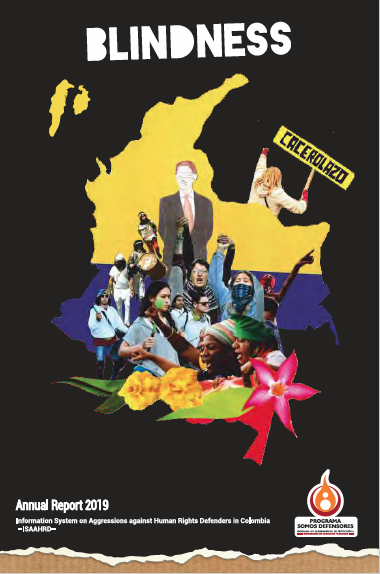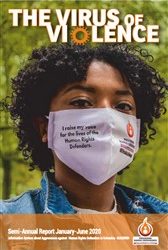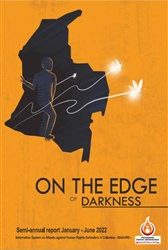
Colombia undoubtedly experien ced a turbulent year during 2019: mass mobilizations, several social protests, ‘Cacerolazos’, intensification of violence in many territories and its return to many others, murders and many more aggressions against human rights defenders; controversies of all kinds between civil society, political movements and even the international community and the National Government, given its denial or blindness in the face of multiple problems and the simulation of the implementation of the Peace Agreement.
Being the first year of government, one would assume that there would be a margin of “tranquility” in the public debate, while the new president took office and routed his government policies. This was not the case. From the beginning, the controversy was raised by the governing party itself, which ignored the Peace Agreement and reversed what had been achieved through it. It was in this context that the debate on the situation of human rights defenders arose, as from the beginning of 2019 the Councilor for Human Rights, Francisco Barbosa, announced a reduction in the number of murders of leadership representatives without solid arguments, but rather from improvisation and with the intention of confronting the debate in the media.
Despite these statements, it was impossible to overshadow reality with words, and the hundreds of attacks against human rights defenders moved the sensibilities of society, which in an immense national and international mobilization on July 26, established its voice of rejection and condemnation of criminality against people who defend the rights of their communities. This was just one of dozens of demonstrations that took place throughout the year in defense of life and peace.
So, to give a broad view to different situations occurred during 2019 that are around the attacks against social leaderships in Colombia, this report entitled Blindness shows the national panorama and emphasizes the denial that characterizes the National Government, on multiple issues related to the critical situation of security and human rights but, in particular, on the problem of criminality against social leaders.
Blindness, is inspired by the book Essay on Blindness, by writer José Saramago, and the disease that in the book spreads throughout the world, making people blind and placing a veil between perception and reality. The same evil that has intentionally settled on the current Government and that, from there, tries to be spread over Colombian society so that only a speech can be heard, superimposing itself on reality and thus, denying it. One of the facts that this veil is trying to cover up, is the serious situation that those who work to defend the rights of social groups and communities face on a daily basis.
Hence, this report is an effort to analyze the context and expose the critical situation to which those who decide to defend human rights in the country are submitted. For this reason, an important part of this publication is the recognition of the men and women whose lives were interrupted early on, as they were victims of those who saw in them obstacles to the development of particular and different types of interests in the territories. Thus, in the first part called In Memory, the profiles of the human rights defenders murdered during the second half of 2019 will be featured.
The first chapter, At the Rhythm of Pans, narrates the episode of the social mobilizations at the end of 2019, around the National Strike, where Colombian society, in demonstrations unprecedented in history and with the lucidity of a mature citizenry, showed the world its discontent with the inequality, injustice and corruption they have been subjected to for decades and which has extended throughout the current government. The latter, however, refused to see and, on the contrary, hid behind a thick blindfold to deny reality and dismiss demands that were impossible to ignore.
A second chapter, entitled Wearing a Well Adjusted Blindfold, brings together the different statements made by the National Government to address the situation of violence against social leaders and, consequently, the public policy proposal, which finally vanished like water through the fingers. This chapter also analyses the actions of the State institutions responsible for the matter, which range from actions that are closer to blindness, to some that come close to lucidity, yet not reaching the amount of light required to extinguish the phenomenon of violence against the social movement and its struggles for the rights of the communities. This section also describes the role of other social and political actors who, in their desire to contribute to raising awareness, rejecting and stopping criminal actions against these people, have stood out in actions and campaigns; this is the case of the international community, the media, the artistic world and civil society.
The third part, A Country between Lights and Shadows, is based on the report of the UN Special Rapporteur on Human Rights Defenders, Michel Forst. It reviews the readings and conclusions of the rapporteur regarding the situation of risk to social leadership in Colombia, which highlights the difficult conditions these people must face in the regions. In addition, it points out the different reactions of the National Government to this report and to that of the Office of the United Nations High Commissioner for Human Rights in Colombia (OHCHR).
Finally, the final chapter contains the statistical analysis provided by the Information System on Aggressions against Human Rights Defenders in Colombia –SIADDHH–. It is based on cases of attacks against leaders, recorded and confirmed by the Somos Defensores Program, which by 2019 shows the difficult panorama for those who defend human rights in the country, with an unprecedented increase in aggressions in our information system, and which leads to the conclusion that there are still no guarantees for the protection of life in the regions. Therefore, we hope that the assessment can serve as a reference for studies, analysis, monitoring of the phenomenon and, ideally, for the creation of public policies that should be implemented to stop this painful situation.
As usual, we would like to thank all the people, social and human rights organizations that contribute substantially to the implementation of this monitoring from the SIADDHH, especially the Center for Research and Popular Education –CINEP–, the Colombia Europe United States Coordination –CCEEU– and the Ombudsman’s Office; the Office of the United Nations High Commissioner for Human Rights in Colombia (OHCHR), the South Colombian Observatory for Human Rights and Violence (OBSURDH), Colombia Diversa, the Association of Indigenous Councils of Northern Cauca (ACIN), the Regional Indigenous Council of Cauca (CRIC), the Territories for a Dignified Life Foundation and the Civic Committee for Human Rights in Meta. In addition, we recognize the Royal Norwegian Embassy in Colombia for its constant political and financial support, and the international cooperation agencies DIAKONIA Sweden, MISEREOR Germany, Amnesty International and Pan Para el Mundo (Bread for the World), whose support is fundamental to advancing our work with human rights defenders in Colombia.





